
Browse an alphabetical list of photographs. These historical images portray people, places, and events before, during, and after World War II and the Holocaust.
<< Previous | Displaying results 2501-2550 of 2641 for "Photo" | Next >>
US troops view bodies of victims of Kaufering IV, a Dachau subcamp in the Landsberg-Kaufering area. Germany, April 30, 1945.
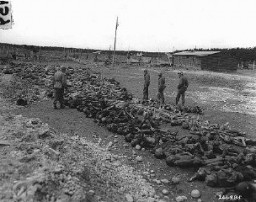
Victims of German SS and Hungarian Arrow Cross terror in the Budapest ghetto. The bodies were found in the courtyard of the Pestor synagogue on Dohany Street. Budapest, Hungary, January 1945.
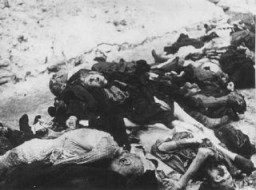
A wagon is piled high with the bodies of victims of the Buchenwald concentration camp. Photograph taken following the liberation of the camp. Buchenwald, Germany, April 16, 1945.
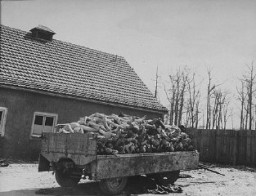
A wagon is piled with the bodies of victims of the Buchenwald concentration camp. Photograph taken following the liberation of the camp. The 6th Armored Division overran the camp on April 11, 1945. Buchenwald, Germany, April 11–May 1945.
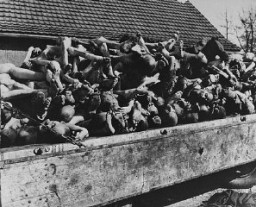
American soldiers look at the exhumed bodies of prisoners who were burned alive in a barn outside Gardelegen. Germany, April 14-18, 1945.
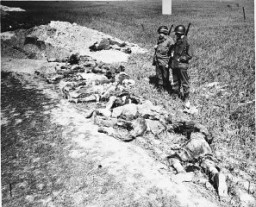
At the Klooga concentration camp, Soviet soldiers examine the bodies of victims left by the retreating Germans. Klooga, Estonia, September 1944.
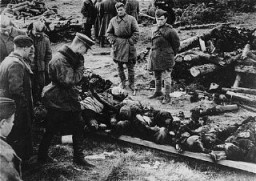
A Soviet soldier walks through a mound of victims' shoes piled outside a warehouse in Majdanek soon after the liberation. Majdanek, Poland, August 1944.
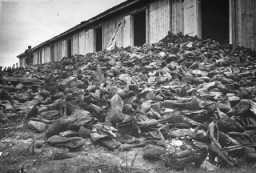
Regina met Victor Gelb, a young Jewish American, in 1950 in Brooklyn. Victor had been drafted into the Korean War. This photograph shows Victor (left) in September 1952. With the end of World War II and collapse of the Nazi regime, survivors of the Holocaust faced the daunting task of rebuilding their lives. With little in the way of financial resources and few, if any, surviving family members, most eventually emigrated from Europe to start their lives again. Between 1945 and 1952, more than 80,000…
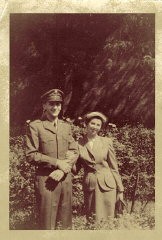
Vidkun Quisling, pro-German Norwegian Fascist leader. Pictured here addressing supporters of his Norwegian Nazi party at a rally. Oslo, Norway, August 1941.
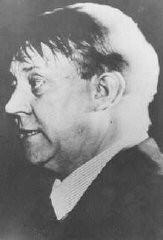
Vidkun Quisling, leader of the collaborationist Norwegian government, returns a salute during a ceremony in Oslo. Norway, after April 1940.
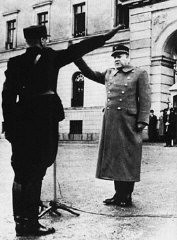
Nyanza is a site near Kigali, Rwanda, where several thousand people were executed after being marched from the Belgian Technical School in April 1994. At the school, they had been under the protection of UN peacekeepers until the soldiers were recalled to the airport to help evacuate expatriates. This is one of the few sites where victims had the honor of individual burial; most often they were buried together in large graves. Photograph taken on November 24, 2007. United States Holocaust Memorial Museum
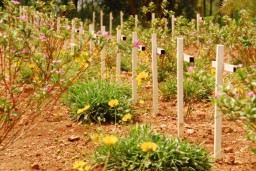
View of a criminal wing in the prison at Nuremberg, housing war crimes trials defendants. Baltic guards under the supervision of American authorities patrol the wing and keep constant watch over the prisoners. The upper floors are screened off with heavy chicken wire to discourage suicide attempts. Nuremberg, Germany, between November 20, 1945, and October 1, 1946.
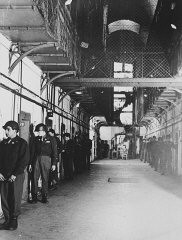
View of the industrial section of the Plaszow camp. Plaszow, Poland, 1944.
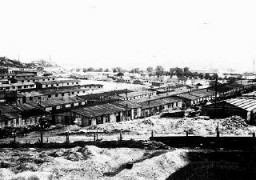
View of the kitchen barracks, the electrified fence, and the gate at the main camp of Auschwitz (Auschwitz I). In the foreground is the sign "Arbeit Macht Frei." This photograph was taken after the liberation of the camp by Soviet forces. Auschwitz, Poland, 1945.
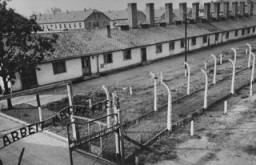
View of Auschwitz-Birkenau under a blanket of snow immediately after the liberation. Auschwitz, Poland, January 1945.
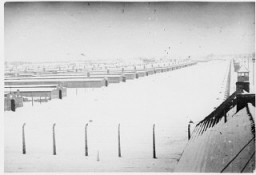
A section of the prisoner barracks in the Majdanek camp. Photograph taken after the liberation of the camp in July 1944. Poland, date uncertain.
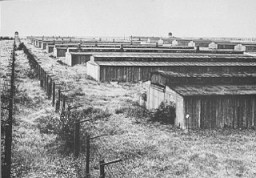
View of Bergen-Belsen concentration camp after the liberation of the camp. A row of small tents has been pitched outside the barracks. A group of survivors huddles in front of one of the tents.
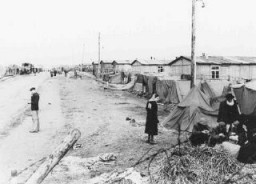
View of a section of the newly liberated Dachau concentration camp as seen through the barbed-wire fence. Dachau, Germany, May 1945.
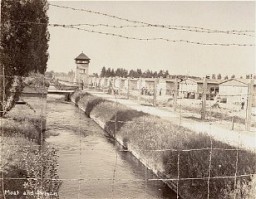
View of Le Chambon, where most of the village's Protestant population hid Jews from the Nazis. Le Chambon-sur-Lignon, France, date uncertain.
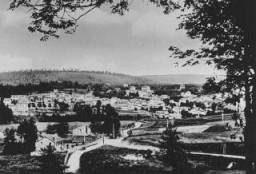
View of Majdanek camp from a nearby village. The smoke could be from the burning of corpses. Poland, October 1943.
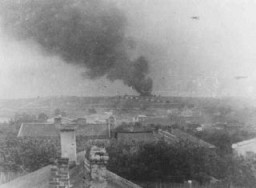
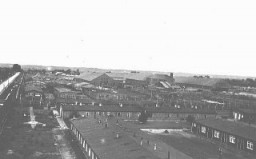
View of the Neuengamme concentration camp. Prisoners stand behind the fence that separates the "protective custody" camp from the manufacturing sectors of the camp. In the distance are the crematorium and the Walther armaments works. Photograph taken between 1940 and 1945, Neuengamme, Germany.
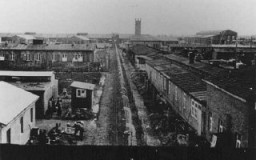
View of one of the mass graves at the Hadamar Institute. This photograph was taken by an American military photographer soon after the liberation. Germany, April 5, 1945.
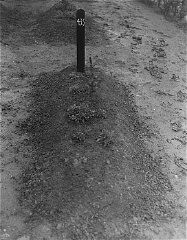
View of part of the Plaszow concentration camp in occupied Poland, showing an entrance gate. Plaszow, Poland, 1943-1944.
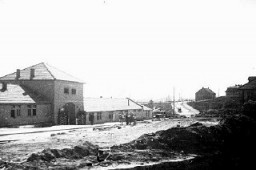
Aerial view of the city of Rotterdam after it was bombed by the Luftwaffe (the German Air Force). Rotterdam, the Netherlands, May–June 1940.
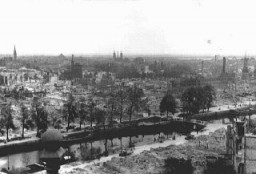
View of Rotterdam after bombing by the German Luftwaffe in May 1940. Rotterdam, the Netherlands, 1940.
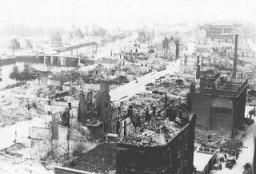
View of Rotterdam after bombing by the German Luftwaffe in May 1940. Rotterdam, the Netherlands, 1940.
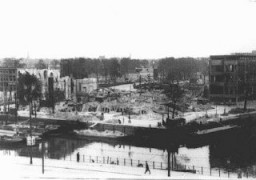
View of the Dachau concentration camp, after liberation on April 29, 1945. It shows the electrified barbed wire fence, the moat, and a watchtower.
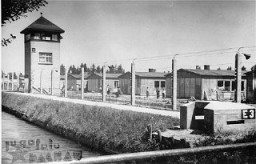
View of the Flossenbürg concentration camp after the liberation of the camp by US forces. Flossenbürg, Germany, 1945.

View of the furnaces remaining in the Majdanek camp by the time of liberation. The Germans had attempted to destroy the building as Soviet forces advanced in 1944. Majdanek, Poland, after July 22, 1944.
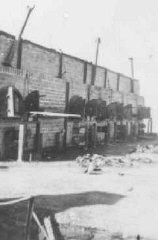
Rare photograph showing a view of the German personnel living quarters at the entrance to the Sobibor killing center in German-occupied Poland.
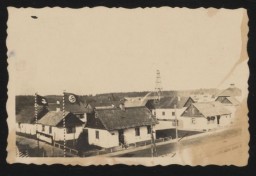
View of the Gusen camp, which became a subcamp of the Mauthausen concentration camp. This photograph was taken after the liberation of the camp. Gusen, Austria, May 1945.
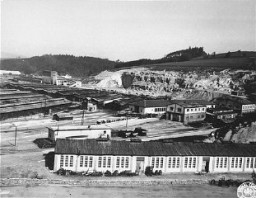
View of the Hadamar Institute. This photograph was taken by an American military photographer soon after the liberation. Germany, April 7, 1945.
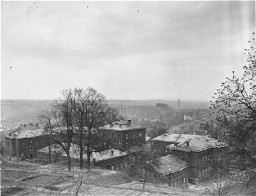
Exterior view of the Hadamar main building. The photograph was taken by an American military photographer soon after the liberation. Germany, April 7, 1945.
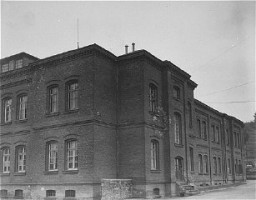
View of the Jasenovac concentration camp in Croatia. Jasenovac, Yugoslavia, 1941-1942.
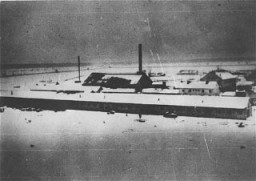
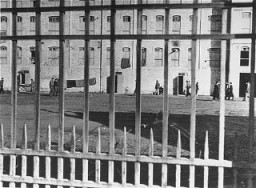
A view of the Maginot Line, a French defensive wall built after World War I. It was intended to deter a German invasion. France, 1940.
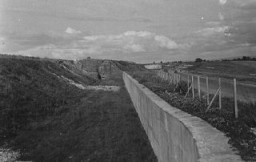
View of the main entrance to the Auschwitz camp. The sign above the gate says "Arbeit Macht Frei" (Work makes one free). Auschwitz, Poland, date uncertain.
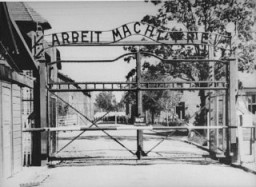
View of the Mariendorf displaced persons (DP) in Berlin, Germany, 1946–1948.
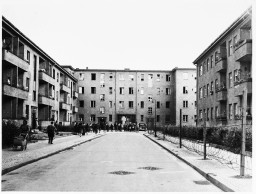
View of the Mauthausen concentration camp. This photograph was taken after the liberation of the camp. Austria, May 5-30, 1945.
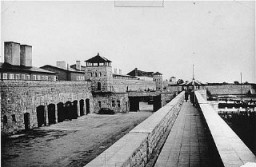
View of buildings in the Natzweiler concentration camp. Beginning in the summer of 1943, the Germans detained many "Night and Fog" prisoners in Natzweiler-Struthof. This photograph was taken following the liberation of the camp. Natzweiler-Struthof, France, 1945.
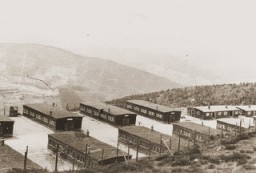
View of the Natzweiler concentration camp. Photograph taken in 1945.
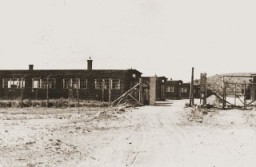
View of the Palace of Justice (left), where the International Military Tribunal trial was held. Nuremberg, Germany, November 17, 1945. The Palace of Justice was selected by the Allied powers as the location for the International Military Tribunal (IMT) because it was the only undamaged facility extensive enough to accommodate a major trial. The site contained 20 courtrooms and a prison capable of holding 1,200 prisoners.
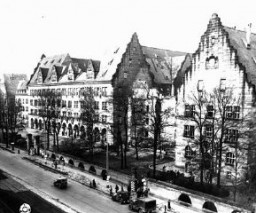
View of a section of the Plaszow concentration camp. Plaszow, Poland, 1943–1944.
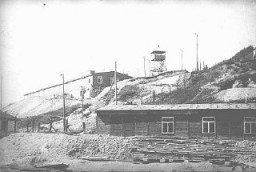
View of the flour mill in Zbaszyn, which served as a refugee camp for Jews expelled from Germany. The Jewish refugees, hungry and cold, were stranded on the border, denied admission into Poland after their explusion from Germany. Photograph taken between October 28, 1938, and August 1939. Warsaw-based historian, political activist, and social welfare worker Emanuel Ringelblum spent five weeks in Zbaszyn, organizing assistance for the refugees trapped on the border.
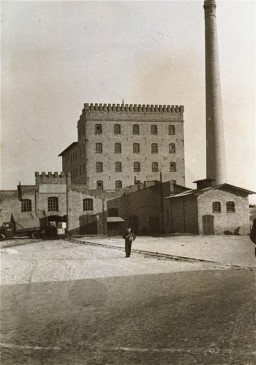
After World War II, the Rothschild hospital in Austria was primarily concerned with the rehabilitation of sick displaced persons. It also served as a lager for political prisoners and as a hostel for 600 refugees.
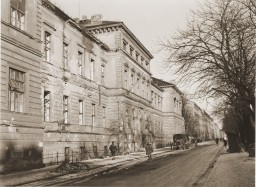
View of the Sobibor camp gate in the spring of 1943. Jews deported to the Sobibor killing center were driven through the gate into the camp on foot, by truck or horse-drawn cart. The train track led through a separate entrance to the right onto the site. Pine branches were braided into the fence to make it difficult to see in from the outside. This image comes from an album and collection kept by Johann Niemann, who became deputy commandant of the Sobibor killing center after holding positions in the…
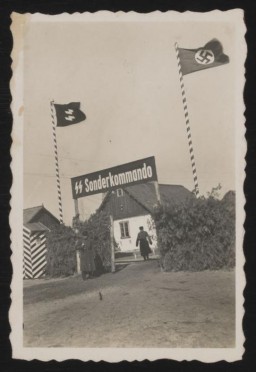
Rare image of the Sobibor killing center, taken from an album of photos belonging to Sobibor deputy camp commandant Johann Niemann.
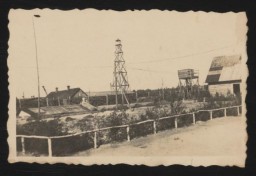
Rare image of the site of the Sobibor killing center, taken from an album of photos belonging to Sobibor deputy camp commandant Johann Niemann.
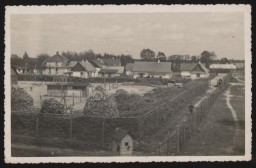
View of the Trawniki training camp showing two barracks and a watch tower. Trawniki, Poland, between 1941 and 1944.
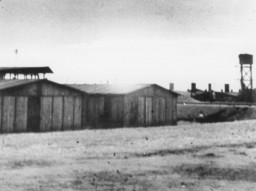
We would like to thank Crown Family Philanthropies, Abe and Ida Cooper Foundation, the Claims Conference, EVZ, and BMF for supporting the ongoing work to create content and resources for the Holocaust Encyclopedia. View the list of donor acknowledgement.